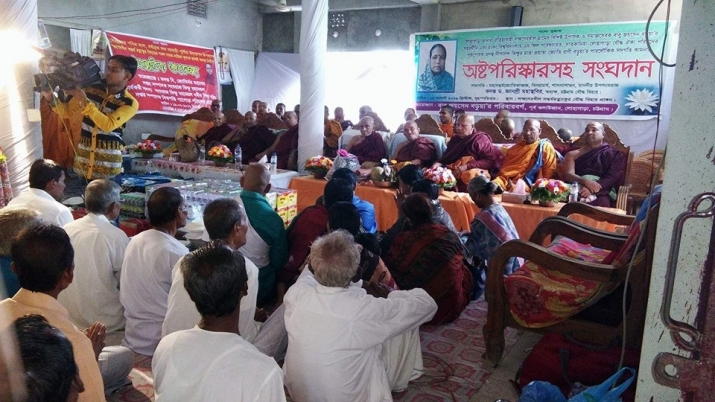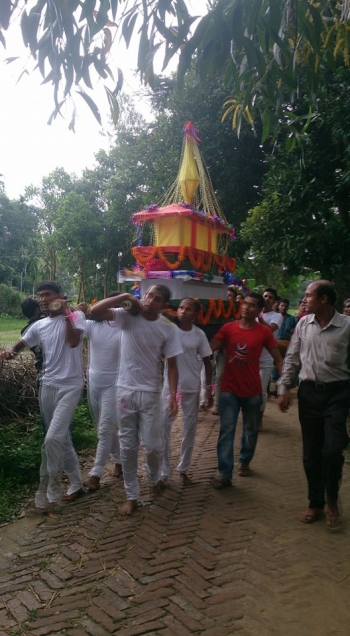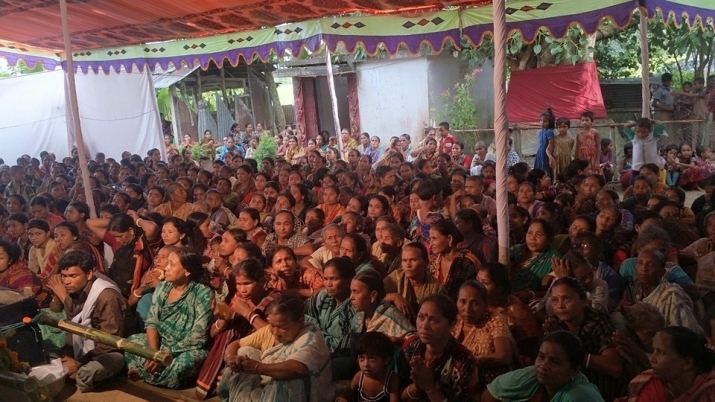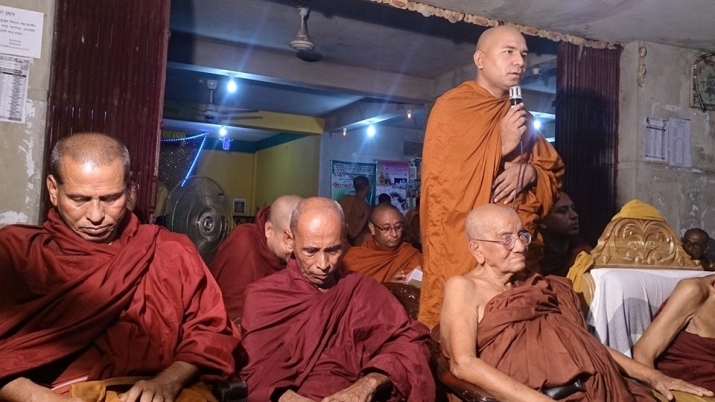Saying Goodbye to My Mother: How Buddhists Hold Funeral Rites in Bangladesh
By BD Dipananda
Buddhistdoor Global
| 2016-09-23 | The funeral ceremony recounted in this article was held for the author’s beloved mother Juti Bala Barua, who passed away on 12 August 2016 and was cremated on the following day. This article is dedicated to her.
 Memorial service on the seventh day after the deceased's passing. Photo by BD Dipananda
Memorial service on the seventh day after the deceased's passing. Photo by BD DipanandaBangladesh is a multicultural country in which Buddhists, Christians, Hindus, Muslims, and some animist groups co-exist alongside one another. The Muslim community in Bangladesh is the dominant demographic, with Buddhists comprising less than 1 per cent of the total population. Within this 1 per cent are diverse tribal ethnicities that are commonly indicated by people’s surnames, such as Barua, Chakma, Marma, Rakhain, and others. Though these groups mainly practice Theravada Buddhism, they also observe interesting rituals and customs that were not originally part of Buddhism but were incorporated into the tradition over many centuries.
One example is that of funeral ceremonies, which are important communal rituals to commemorate the deceased. I helped to organize one for the first time on 13 August for my dear late mother. Here I would like to take the opportunity to show how my country’s rich ethnic cultures have dynamically influenced the funeral rituals for both monastics and lay Buddhists.
Soon after my mother’s passing, thousands of relatives and friends arrived to pay emotional final tributes. In the morning, there was a bathing ceremony, during which the body was washed and sprinkled with perfume. My mother’s body was then placed in a casket surrounded by flowers and moved to the courtyard of a Buddhist temple, accompanied by a slow-moving procession of hundreds of relatives and wellwishers. When the procession arrived at the temple they were seated on mats spread on the floor before of the casket. All of the present family members assembled before the body, and 113 monks then arrived to lend the assembly their spiritual presence.
 Funeral procession of relatives and well wishers. Photo by BD Dipananda
Funeral procession of relatives and well wishers. Photo by BD DipanandaRelatives and friends formed a single line before the casket bearing bouquets of flowers as the monks paid tribute by reciting short mourning verses on behalf of my mother’s family. The congregation recited in liturgical Pali the taking of refuge in the Triple Gem and the undertaking of the Five Precepts, led by a senior monk. The monks then chanted a passage reflecting on the nature of death:
Anicca vata sankhara, uppada vaya dhammino
Uppajjitva nirujjhanti, tesaṃ vupasamo sukho
Alas! all formations are impermanent, it is their nature to arise and cease,
Having arisen, they then pass away, their calming and cession is happiness.
Sabbe satta maranti ca, mariṃsu ca marissare
Tatthevaham marissami, natthi me ettha snsayo
All beings will die, they are of the nature to die,
In the same way I will also die, regarding this I have no doubt.
The next session began with memorializations of the deceased by several relatives. Many of them commented that they never seen such a well-attended Buddhist funeral in a Muslim-majority country such as Bangladesh.
Then the monks gave Dhamma talks on the contemplation of death, before concluding the funeral by sharing the accumulated merit with the departed. Buddhist monastics played an integral role in my mother’s funeral rites, and do the same for many other families.
 The funeral ceremony underway in the temple courtyard. Photo by BD Dipananda
The funeral ceremony underway in the temple courtyard. Photo by BD DipanandaCremation is the most common method of interring the deceased. Soon after the ceremony, eight young people moved the casket to the cemetery, where I lit the first fire of the pyre, followed by other family members and friends. Soon the flames consumed the wood and my mother’s body, reducing both to ashes. According to Bangladeshi Buddhist tradition, the ashes were placed in an urn in the cemetery.
Buddhist funerals in Bangladesh involve many members of the community. Some of them can spend days or even weeks providing food for family members of the deceased. For seven evenings after the deceased's passing, the local monk goes to the home of the bereaved to chant and give teachings on death. On the seventh day, the family members organize a sanghadana (offerings to the sangha). In my case, we also offered alms to 118 monks. All of our family members participated in the ceremony, through which the accumulated merit was offered to my mother. On the 15th day, we also held a more private service, which was conducted by the local temple monks and relatives.
 Monks giving spiritual guidance at the funeral ceremony. Photo by BD Dipananda
Monks giving spiritual guidance at the funeral ceremony. Photo by BD DipanandaThe dynamic of Buddhist funerals in present-day Bangladesh is changing. Once, funerals were conducted by the local monk and characterized by chanting and reflections on the life of the deceased. But depending on economic ability, the deceased’s relatives might nowadays invite the larger community of monks and relatives to participate. Senior monks are also accorded large funerals. Their bodies are preserved for a longer tim—or six months or even as long as two years— and their followers will arrange funerals that last 2–3 days, or even longer. These ceremonies are unique as hundreds of monks and thousands of devotees are invited, with offerings of food and gifts. Funerals for monks are traditionally followed by entertainment, such as religious songs and bands.
On the six-month anniversary of the passing of the deceased, family members perform the sanghadana once again. They will perform memorial services every year, at a family home or at a monastery. These services are demonstration of the relatives’ care for the deceased, and are a way of expressing gratitude to ancestors, through whom family members foster appreciation for one another.
Needless to say, the funeral was a deeply emotional occasion, but also very special experience for me. I feel reassured and have a sense of closure because it was fully imbued with religious and cultural traditions, and with monks providing spiritual guidance to my mother. I feel there could have been no better farewell between us.



















